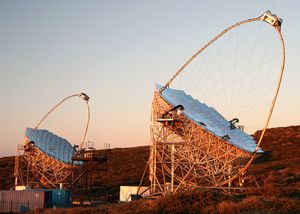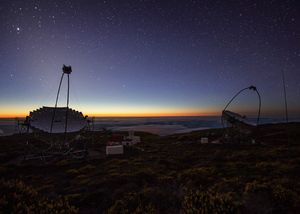MAGIC – Major Atmospheric Gamma Imaging Cherenkov Telescope
With a reflector diameter of 17 meters each, the two MAGIC telescopes are the most sensitive Cherenkov telescopes in the world, especially in the energy range below 200 gigaelectronvolts (GeV). Their line of sight is directed at objects that emit gamma rays ranging from 30 GeV to 100 TeV (teraelectronvolts). This means that MAGIC can cover an enormous energy spectrum.
The twin telescopes are located 2,200 meters above sea level on the Canary Island of La Palma where the clear skies and lack of light pollution make for optimal observing conditions. The Max Planck Institute for Physics (MPP) leads the international collaboration of about 165 astrophysicists from 24 research institutions in eleven countries. Together, they are responsible for the construction, operation and maintenance of the telescopes. MAGIC allows astrophysicists to obtain first class data for gaining scientific insights into enigmatic objects and the most violent processes in the universe.
The MAGIC telescopes have been in operation since 2003 and 2009 respectively. The MPP played a major role in the development and construction of their mechanical structure, imaging cameras and calibration system.
Since the outset, MAGIC has delivered many valuable scientific discoveries.
MAGIC at the MPP
Group members
E-mail address: e-mail@mpp.mpg.de
Phone number: +49 89 32354-extension
name
function
e-mail
extension
office
Altwasser, Doris
Secretary
doris.altwasser
364
A.2.43
Arbet-Engels, Axel, Dr.
Postdoc
axel.arbet-engels
289
A.2.38
Berti, Alessio
Postdoc
alessio.berti
227
A.2.50
Besenrieder, Jürgen
Engineering
juergen.besenrieder
224
A.1.45
Ceribella, Giovanni, Dr.
Postdoc
giovanni.ceribella
291
A.1.61
Chon, Gayoung, PD Dr.
Senior Scientist
gayoung.chon
328
A.1.23
Cicciari, Gloria Maria
gloria.cicciari
227
A.2.50
Gaborit-Reitz, Lucas
Student
lucas.gaborit-reitz
312
A.1.23
Green, Jarred Gershon
PhD Student
jarred.green
259
A.2.44
Hahn, Alexander
PhD Student
alexander.hahn
421
A.2.46
Hamdi, Sajena
Student
sajena.hamdi
506
A.2.50
Jimenez Martinez, Irene, Dr.
Postdoc
irene.jimenez
364
A.2.52
Kelkar, Varun Shriram
Student
varun.kelkar
259
A.2.44
Marino, Francesco
Intern
francesco.marino
328
A.1.47
Mirzoyan, Razmik, Dr.
Senior Scientist
razmik.mirzoyan
328
A.2.34
Paneque, David, Dr.
Senior Scientist
david.paneque
349
A.2.36
Peresano, Michele, Dr.
Postdoc
michele.peresano
543
A.2.52
Pirola, Giorgio
PhD Student
giorgio.pirola
259
A.2.44
Schweizer, Thomas, Dr.
Senior Scientist
thomas.schweizer
227
A.2.32
Scola, Lalo
Student
lalo.scola
364
A.2.54
Strom, Derek, Dr.
Engineering
derek.strom
422
B.2.11
Teshima, Masahiro, Dr.
Director
masahiro.teshima
301
A.2.41
Wang, Yunhe
Student
yunhe.wang
312
A.2.52
Werner, Diana
Secretary
diana.werner
364
A.2.43
van Scherpenberg, Juliane
PhD Student
juliane.van.scherpenberg
421
A.2.46
Ünver, Asu Nisa
Student
asu.unver
291
A.1.61
Group members
Phone number: +49 89 32354-extension
| name | function | extension | office | |
|---|---|---|---|---|
| Altwasser, Doris | Secretary | doris.altwasser | 364 | A.2.43 |
| Arbet-Engels, Axel, Dr. | Postdoc | axel.arbet-engels | 289 | A.2.38 |
| Berti, Alessio | Postdoc | alessio.berti | 227 | A.2.50 |
| Besenrieder, Jürgen | Engineering | juergen.besenrieder | 224 | A.1.45 |
| Ceribella, Giovanni, Dr. | Postdoc | giovanni.ceribella | 291 | A.1.61 |
| Chon, Gayoung, PD Dr. | Senior Scientist | gayoung.chon | 328 | A.1.23 |
| Cicciari, Gloria Maria | gloria.cicciari | 227 | A.2.50 | |
| Gaborit-Reitz, Lucas | Student | lucas.gaborit-reitz | 312 | A.1.23 |
| Green, Jarred Gershon | PhD Student | jarred.green | 259 | A.2.44 |
| Hahn, Alexander | PhD Student | alexander.hahn | 421 | A.2.46 |
| Hamdi, Sajena | Student | sajena.hamdi | 506 | A.2.50 |
| Jimenez Martinez, Irene, Dr. | Postdoc | irene.jimenez | 364 | A.2.52 |
| Kelkar, Varun Shriram | Student | varun.kelkar | 259 | A.2.44 |
| Marino, Francesco | Intern | francesco.marino | 328 | A.1.47 |
| Mirzoyan, Razmik, Dr. | Senior Scientist | razmik.mirzoyan | 328 | A.2.34 |
| Paneque, David, Dr. | Senior Scientist | david.paneque | 349 | A.2.36 |
| Peresano, Michele, Dr. | Postdoc | michele.peresano | 543 | A.2.52 |
| Pirola, Giorgio | PhD Student | giorgio.pirola | 259 | A.2.44 |
| Schweizer, Thomas, Dr. | Senior Scientist | thomas.schweizer | 227 | A.2.32 |
| Scola, Lalo | Student | lalo.scola | 364 | A.2.54 |
| Strom, Derek, Dr. | Engineering | derek.strom | 422 | B.2.11 |
| Teshima, Masahiro, Dr. | Director | masahiro.teshima | 301 | A.2.41 |
| Wang, Yunhe | Student | yunhe.wang | 312 | A.2.52 |
| Werner, Diana | Secretary | diana.werner | 364 | A.2.43 |
| van Scherpenberg, Juliane | PhD Student | juliane.van.scherpenberg | 421 | A.2.46 |
| Ünver, Asu Nisa | Student | asu.unver | 291 | A.1.61 |
Key publications
Detection of very high energy gamma-ray emission from the gravitationally-lensed blazar QSO B0218+357 with the MAGIC telescopes
MAGIC Collaboration
arxiv:1609.01095
Teraelectronvolt pulsed emission from the Crab Pulsar detected by MAGIC
MAGIC Collaboration
Astronomy & Astrophysics, Volume 585 (January 2016)
doi:10.1051/0004-6361/201526853
Very high Energy γ-Ray from the universe’s middle age: Detection of the z = 0.940 Blazar PKS 1441+25 with MAGIC
Magic Collaboration
The Astrophysical Journal Letters, 815:L23 (8pp), 2015 December 20
doi:10.1088/2041-8205/815/2L23
Key publications
Detection of very high energy gamma-ray emission from the gravitationally-lensed blazar QSO B0218+357 with the MAGIC telescopes
MAGIC Collaboration
arxiv:1609.01095
Teraelectronvolt pulsed emission from the Crab Pulsar detected by MAGIC
MAGIC Collaboration
Astronomy & Astrophysics, Volume 585 (January 2016)
doi:10.1051/0004-6361/201526853
Very high Energy γ-Ray from the universe’s middle age: Detection of the z = 0.940 Blazar PKS 1441+25 with MAGIC
Magic Collaboration
The Astrophysical Journal Letters, 815:L23 (8pp), 2015 December 20
doi:10.1088/2041-8205/815/2L23
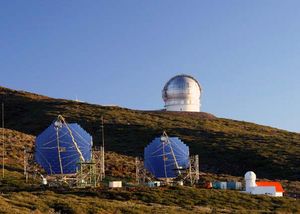
![[Translate to English:] #33956 Left: The MAGIC telescopes on the island of La Palma. Right: Data from the eruption of the active galactic nucleus (AGN) Markarian 421, measured with MAGIC (gamma rays) and IXPE (X-rays) in December 2023 (Photo: Urs Leutenegger, Data: Axel Arbet-Engels)](/fileadmin/_processed_/f/6/csm_plot_pr_ebb05fd048.jpg)
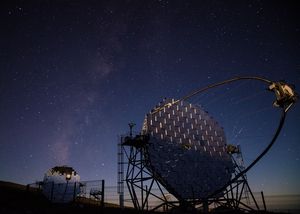
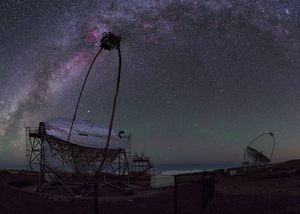
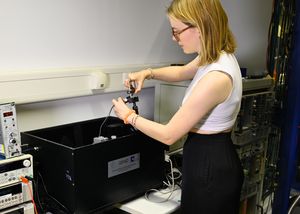
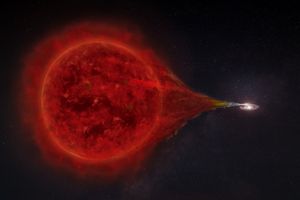
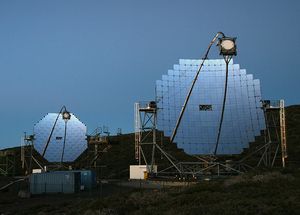
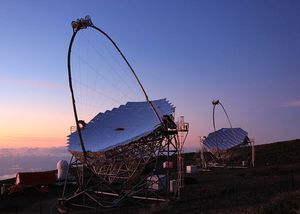
![[Translate to English:] Artistic view of a gamma-ray burst with jet](/fileadmin/_processed_/d/5/csm_GRB-2_hi_fa65487d6c.jpg)
